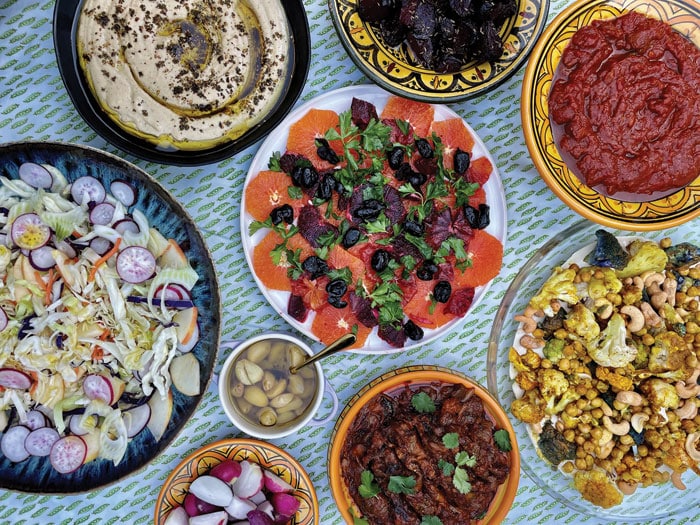Breaking the Fast Is a Piece of Cake
Soft and fluffy, light and airy, there’s something special about sponge cakes. They bring back feelings of home and memories from a time long gone.

Soft and fluffy, light and airy, there’s something special about sponge cakes. They bring back feelings of home and memories from a time long gone. A classic dessert, sponge cake speaks of afternoon teas and momentous celebrations.
For me, especially at this time of year, sponge cake whispers memories of Yom Kippur. My mother would bake sponge cakes throughout the year, but we definitely had to have sponge cake for Yom Kippur. My brothers and I would wolf down a slice with a glass of my mother’s fresh Moroccan mint tea. It was the last thing we would eat, before rushing out the door to be at the synagogue in time for the Kol Nidrei prayers.
Sponge cake seems intimidating and many home bakers won’t even attempt to make it, convinced that their cake just won’t rise. But the recipe I share with you is a sure thing. While you may be shocked by the amount of baking powder required (3 tablespoons), this leavening agent guarantees that perfect high rise and deliciously light, spongy texture.
Cooking is an art, but baking is a fine science, so be sure to follow the recipe directions carefully.
Cooking is an art, but baking is a fine science, so be sure to follow the recipe directions carefully.
There are some tips that will make your baking go smoothly. Use a clean, dry bowl for the egg whites. Separate the eggs while they are just out of the refrigerator and still cold (this ensures that the yolk will not break and ruin the egg whites). Allow the eggs to come to room temperature before beating them and add the sugar slowly.
You must bake the cake in a tube pan because the tube helps the cake bake faster and higher. Make sure not to grease the tube part, only the bottom and side part of the pan.
Don’t open the oven door until you are ready to remove the cake from the oven. When the cake is fully baked, immediately flip the pan over. Suspending the cake upside down means that the warm steam doesn’t deflate the sponge. Allow cake to fully cool upside down in pan.
I promise that this is a recipe you’ll want to make again and again.
—Rachel
There are certain things that only someone who grew up in a former British colony can truly appreciate. Between Alan (Johannesburg, South Africa) and I (Sydney, Australia), it’s almost an unspoken common language. The headmaster hierarchy, the school uniforms, the little brown suitcases that we carried to school. His obsession with watching sports and playing sports, especially cricket and rugby, tennis and swimming. The food — the little sandwiches, the scones, the creamy tarts, not to mention our family favorites — a good roast chicken with potatoes and a wonderful shepherd’s pie.
So when I joined the Gomperts family, I wasn’t surprised that my mother-in-law Yvonne always bakes a perfectly delicious sponge cake for family birthday celebrations.
There is nothing more British than a sponge cake. The idea of replacing yeast as a leavening agent with stiffly beaten egg whites may have originated in Renaissance Spain or Italy. But it was the invention of baking powder by the English food manufacturer Alfred Bird in 1843 that truly popularized the sponge cake. In a romantic nod to the young Queen Victoria, British chefs created the Victoria sponge, a cake layered with fresh whipped cream and strawberry or raspberry jam.
While Rachel’s family starts the Yom Kippur fast with a slice of sponge cake, my mother-in-law usually bakes a sponge for the Yom Kippur breakfast meal. Let me tell you that after 25 hours of fasting, nothing tastes better!
Wishing you and your family and all of Am Israel a G’mar Chatima Tova. May we be inscribed for a year of health and happiness, peace and prosperity.
—Sharon

Sponge Cake
7 egg whites
5 egg yolks
1 1/2 cups sugar, divided
1/4 tsp cream of tartar
1 tsp vanilla extract
1/2 cup vegetable oil
1 Tbsp orange or lemon zest
3/4 cup of orange juice or water
2 1/4 cups plain flour
3 Tbsp baking powder
Preheat oven to 325°F.
Grease the bottom and sides of the tube pan. Do not grease the middle tube. In a clean bowl, slowly beat the egg whites until they become foamy. Gradually add the 3/4 cup of sugar and the cream of tartar and beat until the whites are thick and velvety and form stiff peaks.
In a large bowl, beat the egg yolks with the remaining sugar until the mixture is a pale yellow. Add the vanilla, oil, zest and juice and beat well.
Gradually add the flour and baking powder until the cake mixture is smooth and well blended.
Gently fold the egg whites into the cake mixture.
Pour the batter into the greased cake pan.
Bake for 40 minutes, then raise the temperature to 350°F and bake for 10 more minutes.
Cake is baked when a toothpick comes out clean.
Remove the cake from the oven and invert the pan onto a cooling rack.
Allow the cake to cool completely, without touching the pan.
Gently remove from the cake pan and place on a serving dish.
Sharon Gomperts and Rachel Emquies Sheff have been friends since high school. The Sephardic Spice Girls project has grown from their collaboration on events for the Sephardic Educational Center in Jerusalem. Follow them
on Instagram @sephardicspicegirls and on Facebook at Sephardic Spice SEC Food.







